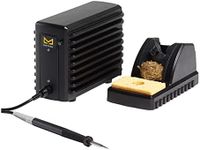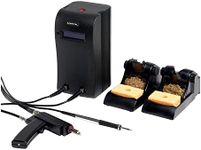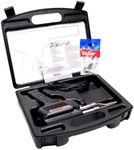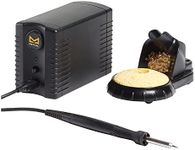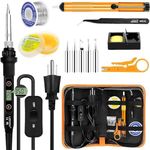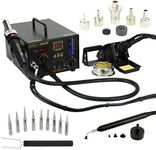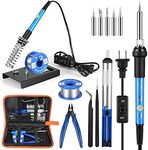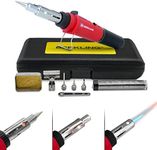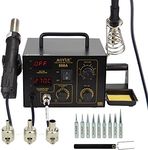Buying Guide for the Best Soldering Guns
Choosing the right soldering gun is important for anyone interested in electronics, DIY repairs, or crafting. The right tool can make your work easier, safer, and more precise. When picking a soldering gun, you should consider what types of projects you'll be working on, how often you'll use the tool, and your comfort level with handling different sizes and features. Understanding the key specifications will help you find a soldering gun that matches your needs and ensures good results.WattageWattage refers to the power output of the soldering gun and is a key factor in how quickly the tool heats up and how well it can maintain its temperature. Lower wattage (20-40W) is suitable for delicate electronics and small wires, as it provides enough heat without damaging sensitive components. Medium wattage (40-80W) is more versatile and can handle a wider range of tasks, including small appliances and general repairs. High wattage (above 80W) is best for heavy-duty work, such as soldering thick wires or metal parts. To pick the right wattage, think about the size and type of materials you'll be working with most often—delicate work needs less power, while larger jobs require more.
Tip Type and SizeThe tip of a soldering gun is the part that actually touches the workpiece and melts the solder. Tips come in different shapes and sizes, such as pointed, chisel, or flat. Smaller, finer tips are ideal for precision work on small circuit boards, while larger, broader tips are better for bigger joints or heavy wires. Choosing the right tip depends on the detail and scale of your projects—if you work on tiny electronics, go for a fine tip; for general repairs or larger items, a broader tip will be more efficient.
Temperature ControlTemperature control allows you to adjust how hot the soldering gun gets. Some models have fixed temperatures, while others let you set the heat level. Adjustable temperature is important if you work with different types of solder or components, as some materials require more or less heat. If you only do basic repairs, a fixed temperature may be enough, but for varied or sensitive work, adjustable temperature gives you more flexibility and helps prevent damage.
Heating TimeHeating time is how quickly the soldering gun reaches its working temperature after being turned on. Faster heating means less waiting and more efficient work, which is useful if you need to do quick jobs or don't want to waste time. If you use the tool often or for short tasks, look for a model with a quick heat-up time. For occasional use, a slower heating gun may still be acceptable.
Ergonomics and WeightErgonomics refers to how comfortable and easy the soldering gun is to hold and use, while weight affects how long you can work without fatigue. A well-designed handle and balanced weight make it easier to control the tool, especially during long sessions. If you plan to use the soldering gun frequently or for extended periods, prioritize comfort and a lighter model. For occasional or short-term use, ergonomics may be less critical.
Safety FeaturesSafety features can include things like heat-resistant handles, automatic shut-off, and indicator lights. These features help prevent burns, accidental fires, and other hazards. If you are new to soldering or will be working in a shared or home environment, look for models with good safety features to reduce risks.
